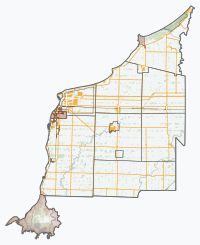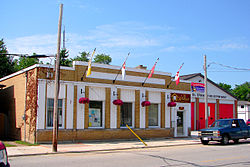
Dawn-Euphemia is a township in southwestern Ontario, Canada, in Lambton County. Residents primarily are employed by the agricultural industry, or by local industries such as Union Gas distribution centre, along with various smaller agricultural manufacturers or service providers. The township municipal office is located in Rutherford.

Lambton County is a county in Southwestern Ontario, Canada. It is bordered on the north by Lake Huron, which is drained by the St. Clair River, the county's western border and part of the Canada-United States border. To the south is Lake Saint Clair and Chatham-Kent. Lambton County's northeastern border follows the Ausable River and Parkhill Creek north until it reaches Lake Huron at the beach community of Grand Bend. The county seat is in the Town of Plympton-Wyoming.

Petrolia is a town in southwestern Ontario, Canada. It is part of Lambton County and is surrounded by Enniskillen Township. It is billed as "Canada's Victorian Oil Town" and is often credited with starting the oil industry in North America, a claim shared with the nearby town of Oil Springs.

Thomas Sterry Hunt was an American geologist and chemist.

Alexander Murray, was a Scottish geologist. Murray is best known for his career with the Geological Survey of Canada and the Geological Survey of Newfoundland.

Sarnia—Lambton is a federal electoral district in Ontario, Canada, that has been represented in the House of Commons of Canada since 1968. It is located in the area of the city of Sarnia, in the southwest corner of the province of Ontario.

Englehart is a town in the Canadian province of Ontario, located on the Blanche River in the Timiskaming District.
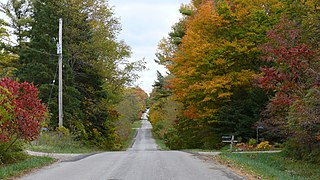
Bayham is a municipality in the southeast corner of Elgin County, Ontario, Canada. It is south of the town of Tillsonburg and Oxford County.
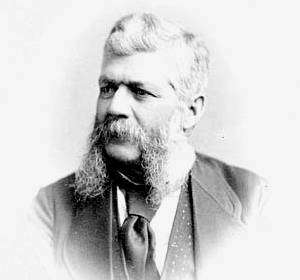
James Miller Williams was a Canadian-American businessman and politician. Williams is best known for establishing the first commercially successful oil well in 1858 and igniting the first oil boom in North America. Williams is commonly viewed as the father of the petroleum industry in Canada.

The Canadian petroleum industry arose in parallel with that of the United States. Because of Canada's unique geography, geology, resources and patterns of settlement, however, it developed in different ways. The evolution of the petroleum sector has been a key factor in the history of Canada, and helps illustrate how the country became quite distinct from her neighbour to the south.

John Henry Fairbank was variously a surveyor, oilman, inventor, banker, politician and fire chief in Lambton County, Ontario. Fairbank is best known for his invention of the jerker-line pumping system, which quickly spread across the world its introduction in the mid-1860s. Fairbank Oil, established by Fairbank in 1861, is the oldest continually operating petroleum company, and the company's property, known as the "First Commercial Oil Field," is included in the List of National Historic Sites of Canada in Ontario.

Enniskillen is a township in the Canadian province of Ontario, within Lambton County. It is located at the intersection of Highway 21 and Rokeby Line. The economy of the township is based on agriculture. It was named after Sir Galbraith Lowry Cole's father who was the Earl of Enniskillen, Northern Ireland.

Osler is a town in the Canadian province of Saskatchewan, founded in the 1890s. The community was named after Sir Edmund Boyd Osler (1845–1924), who was an Ontario-based explorer, railroad financier, and Member of Parliament.
Charles Nelson Tripp was a bitumen businessman in Ontario. Tripp is best known for his role in the formation of the International Mining and Manufacturing Company in 1854, the world's first incorporated oil company. Tripp and his brother Henry were among the first to exploit Enniskillen Township's bitumen deposits following Thomas Sterry Hunt and Alexander Murray's reports on the region and helped kickstart the first oil boom in Enniskillen Township.
Major Charles Oliver "Chas" Fairbank (1858–1925) was a Canadian oilman and military officer and M.D. who served in the First World War.
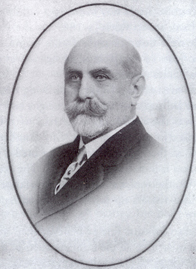
Jacob Lewis Englehart was a Canadian-American business magnate, entrepreneur and philanthropist. Englehart is best known for his role in the formation of Imperial Oil in 1880 to combat the growing influence of John D. Rockefeller's Standard Oil. Englehart was one of the most successful oil refiners in Canada during the 1800's and oversaw the completion of the Temiskaming and North Ontario Railway.
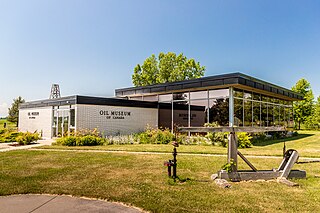
The Oil Museum of Canada, is a petroleum heritage museum in Oil Springs, Ontario, Canada. The museum is located on the site where James Miller Williams dug the first commercial oil well on the continent in 1858.

Hugh Nixon Shaw is an Irish-Canadian oil producer and businessman. Shaw is best known for being misidentified as the discoverer of the Shaw well, Canada's first oil gusher, on January 16, 1862.
John Shaw was an American oil driller, businessman and photographer. Shaw is best known for striking Canada's first oil gusher at Oil Springs on January 16, 1862. Shaw's oil gusher marked the beginning of the first oil boom in Enniskillen Township, as speculators rushed to Oil Springs seeking similar fortunes.
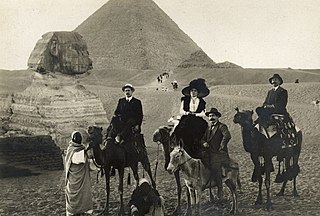
The International Drillers is the name given to the more than 500 drillers from Lambton County who worked in oil fields across the world between December 1873 to the mid-1940s. Many of the International Drillers grew up learning the oil business in Enniskillen County and provided the skilled labour, expertise and technology necessary for the development of the global petroleum industry.

